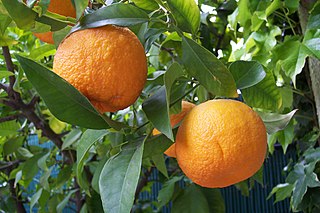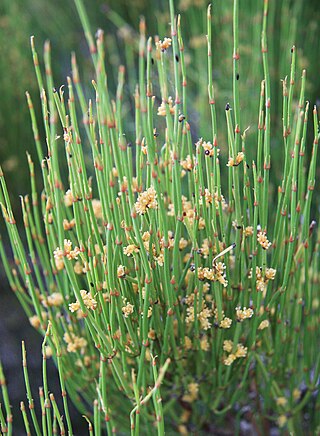In the Vedic tradition, sóma is a ritual drink of importance among the early Vedic Indo-Aryans. The Rigveda mentions it, particularly in the Soma Mandala. Gita mentions the drink in chapter 9. It is equivalent to the Iranian haoma.
Haoma is a divine plant in Zoroastrianism and in later Persian culture and mythology. Haoma has its origins in Indo-Iranian religion and is the cognate of Vedic soma.

A dietary supplement is a manufactured product intended to supplement a person's diet by taking a pill, capsule, tablet, powder, or liquid. A supplement can provide nutrients either extracted from food sources, or that are synthetic. The classes of nutrient compounds in supplements include vitamins, minerals, fiber, fatty acids, and amino acids. Dietary supplements can also contain substances that have not been confirmed as being essential to life, and so are not nutrients per se, but are marketed as having a beneficial biological effect, such as plant pigments or polyphenols. Animals can also be a source of supplement ingredients, such as collagen from chickens or fish for example. These are also sold individually and in combination, and may be combined with nutrient ingredients. The European Commission has also established harmonized rules to help insure that food supplements are safe and appropriately labeled.

Ephedrine is a central nervous system (CNS) stimulant that is often used to prevent low blood pressure during anesthesia. It has also been used for asthma, narcolepsy, and obesity but is not the preferred treatment. It is of unclear benefit in nasal congestion. It can be taken by mouth or by injection into a muscle, vein, or just under the skin. Onset with intravenous use is fast, while injection into a muscle can take 20 minutes, and by mouth can take an hour for effect. When given by injection it lasts about an hour and when taken by mouth it can last up to four hours.

Bitter orange, sour orange, Seville orange, bigarade orange, or marmalade orange is in a narrow sense the citrus tree Citrus × aurantium and its fruit. It is native to Southeast Asia and has been spread by humans to many parts of the world. It is probably a cross between the pomelo, Citrus maxima, and the mandarin orange, Citrus reticulata.

Herbal medicine is the study of pharmacognosy and the use of medicinal plants, which are a basis of traditional medicine. With worldwide research into pharmacology, some herbal medicines have been translated into modern remedies, such as the anti-malarial group of drugs called artemisinin isolated from Artemisia annua, a herb that was known in Chinese medicine to treat fever. There is limited scientific evidence for the safety and efficacy of many plants used in 21st-century herbalism, which generally does not provide standards for purity or dosage. The scope of herbal medicine sometimes include fungal and bee products, as well as minerals, shells and certain animal parts.

Mitragyna speciosa is a tropical evergreen tree in the coffee family native to Southeast Asia. It is indigenous to Thailand, Indonesia, Malaysia, Myanmar, and Papua New Guinea, where it has been used in herbal medicine since at least the 19th century. It has also historically been used for chewing, smoking, and tea. Kratom has opiate properties and some stimulant-like effects.
The ECA stack is a drug combination used in weight loss and as a stimulant. ECA is an initialism for ephedrine, caffeine, and aspirin, with variants of it including the EC stack, which removes the aspirin for those who can not tolerate it. Dietary supplements based on or including elements of ECA were popular through the 1990s and early 2000s, but the marketing of ephedra- or ephedrine-containing stimulant combinations for weight loss and bodybuilding is now restricted or illegal in the United States and the Netherlands due to reports of heart attack, stroke, and death associated with these supplements.

Ephedra is a genus of gymnosperm shrubs. The various species of Ephedra are widespread in many arid regions of the world, ranging across southwestern North America, southern Europe, northern Africa, southwest and central Asia, northern China and western South America. It is the only extant genus in its family, Ephedraceae, and order, Ephedrales, and one of the three living members of the division Gnetophyta alongside Gnetum and Welwitschia.
There has been much speculation as to the botanical identity of soma or haoma. Soma is a plant described in Hindu sacred texts including the Rigveda, while haoma is a plant described in the Avesta, a collection of Zoroastrian writings. Both names are derived from the Proto-Indo-Iranian *Sauma. Proposed candidates include various species of plants and or fungi. Traditional etymology of Indian Soma is Somalata used traditionally by the Srauta Brahmins called Somayajis whereas the Avestan Haoma is an Ephedra, which are totally unconnected species sourced from different areas. European researchers suggest other plants, such as the perennial Peganum harmala, Nelumbo nucifera, Cannabis sativa, and the sugarcane species Tripidium bengalense ; while fungal candidates include the fly-agaric mushroom Amanita muscaria, the psilocybin-containing mushroom Psilocybe cubensis, and the ergot fungus Claviceps purpurea. Other scholarly proposals include mixtures of these candidates with each other and with other substances.
Hydroxycut is a brand of dietary supplements that is marketed as a weight loss aid. Hydroxycut was originally developed and manufactured by MuscleTech Research and Development; MuscleTech was sold to Iovate Health Sciences in 2003–2004 and declared bankruptcy in 2005; Iovate continues to use MuscleTech as a brand to market Hydroxycut.

Ephedra sinica is a species of Ephedra native to Mongolia, Russia, and northeastern China.
Steven Scott Bechler was an American professional baseball pitcher who played in Major League Baseball (MLB) for the Baltimore Orioles.
Dexatrim is an over-the-counter (OTC) dietary supplement meant to assist with weight loss. Dexatrim claims it "gives you the power to lose weight, curb binges, and keep you in control of your diet." Current Dexatrim products available are in capsule form and include Dexatrim Max Complex 7, Dexatrim Max Daytime Appetite Control, Dexatrim Natural Green Tea, and Dexatrim Natural Extra Energy. The major active ingredients found in current Dexatrim products include caffeine, green tea extract, Asian (Panax) ginseng root extract, and dehydroepiandrosterone (DHEA).
Metabolife International, Inc. was a multi-level marketing company based in San Diego, California which manufactured dietary supplements. Metabolife's best-selling product, an ephedra supplement called Metabolife 356, once generated hundreds of millions of dollars in annual sales. However, Metabolife 356 and other ephedra-containing supplements were linked to thousands of serious adverse events, including deaths, which caused the U.S. Food and Drug Administration (FDA) to ban the sale of ephedra-containing dietary supplements in 2004.

Methylhexanamine is an indirect sympathomimetic drug invented and developed by Eli Lilly and Company and marketed as an inhaled nasal decongestant from 1948 until it was voluntarily withdrawn from the market in the 1980s.
The Chemins Company is a dietary supplement manufacturer based in Colorado Springs, Colorado. The company, founded in 1974 by James Cameron, became embroiled in a series of criminal investigations in 1994 after a woman died and more than 100 other people became ill after taking one of the company's products marketed under the brand name Nature's Nutrition Formula One. The adverse events were later linked to the product having been tainted with ephedrine. A three-year federal investigation, which revealed that the company had doctored records, misled FDA investigators, and purposely hindered inspections, led to Cameron being sentenced to 21 months in prison and him and the company being fined $4.7 million. The company also paid out $750,000 to settle a class action lawsuit alleging that the company's protein powder supplements contained approximately half the protein content and twice the carbohydrate content listed on the label.

The Dietary Supplement Health and Education Act of 1994 ("DSHEA"), is a 1994 statute of United States Federal legislation which defines and regulates dietary supplements. Under the act, supplements are regulated by the FDA for Good Manufacturing Practices under 21 CFR Part 111. The act was intended to exempt the dietary and herbal supplement industry from most FDA drug regulations, allowing them to be sold and marketed without scientific backing for their health and medical claims.
Pre-workout is a generic term for a range of bodybuilding supplement products used by athletes and weightlifters to enhance athletic performance. Supplements are taken to increase endurance, energy, and focus during a workout. Pre-workout supplements contain a variety of ingredients such as caffeine and creatine, differing by capsule or powder products. The first pre-workout product entered the market in 1982, and since then the category has grown in use. Some pre-workout products contain ingredients linked to adverse effects. Although these products are not regulated, the Food and Drug Administration (FDA) warns consumers to be cautious when consuming them.










